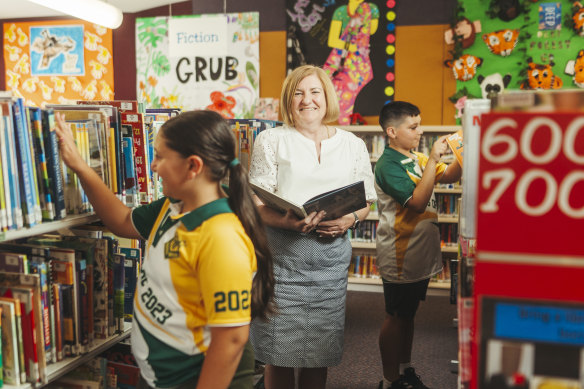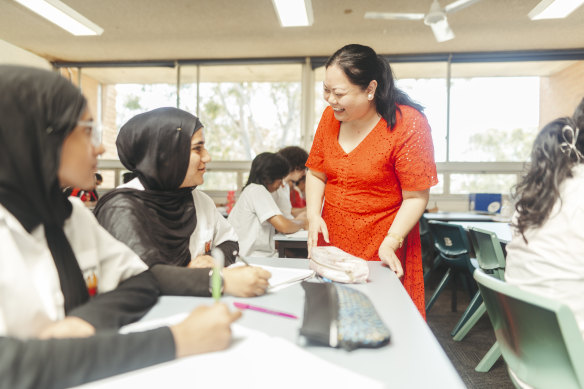Save articles for later
Add articles to your saved list and come back to them any time.
Every Friday morning before class, graduate teachers at Fairfield Heights Public School attend a mentoring program.
The course runs for a year but for the first six months they only focus on one thing: behaviour management.
Deputy principal Tanya Benetel with year 6 school captains Anabella Aghostin and Yaco Lazer at Fairfield Heights Public School.Credit: Dion Georgopoulos
“That is the most challenging thing facing a brand new teacher coming into any school,” says principal Susan Craig.
“You have to earn their respect by demonstrating your respect for the children, by communicating clearly, but giving explicit feedback. That’s not taught at university so we actually have to teach the teachers how to do that.”
Fairfield Heights Public School is one of 100 NSW schools identified by the Australian Curriculum, Assessment and Reporting Authority as high achieving in this year’s NAPLAN results, meaning students showed above-average literacy and numeracy results compared with pupils of similar socio-educational backgrounds.
High-fee private schools, including Abbotsleigh in Wahroonga, Newington in Stanmore and Kambala in Rose Bay, all performed better than similar schools in reading, writing, spelling, grammar and numeracy.
Kellyville Public, Earlwood Public and Cranebrook High are among the top-performing public schools in Sydney.
Of the 740 pupils at Fairfield Heights, 40 per cent have a refugee background, 70 per cent come from the lowest socio-economic background and 93 per cent don’t speak English at home.
Their school has no open-plan classrooms, children sit in rows and are assessed every five weeks on their progress in reading, writing and maths.
Similar to the education system in Singapore, class teachers are given a program for the year detailing how the curriculum should be translated into lessons. They also have a highly regimented timetable that prioritises reading and numeracy.
“We don’t have any discipline issues and that’s because programs are designed to be highly structured and engage the students,” Craig said.
Deputy principal Tanya Benetel said they were focused on explicit teaching because a lot of children arrived without having attended preschool and might never have picked up a book.
“It is just good old-fashioned teaching … we just teach them right from the start in a good, structured, sequential way,” she said.
Plumpton High near Mount Druitt in Sydney’s west also achieved NAPLAN scores exceeding those of similar schools.
It offers numerous extracurricular activities such as the Duke of Edinburgh award, but principal Tim Lloyd is unapologetic about the focus on literacy and numeracy.
Head teacher of English Katherine Gonzaga at Plumpton High School.Credit: Dion Georgopoulos
“If you can’t read and write and add up you’re going to be well and truly left behind,” he said.
Every student’s reading ability is assessed in year 7, and they are provided a significant number of books matching their reading ability as part of a program. Upon its completion they sit a comprehension test and may move up a level.
“It’s taken our reading results from well below similar school groups basically to the equivalent of the NSW level, well above similar schools,” Lloyd said.
There are also remedial classes for those who enter high school with the reading skills of a primary school-aged student.
Reading for 15 minutes is mandatory in years 7, 8 and 9 for the first 15 minutes of every English, science, and human and society and its environment lesson.
“To get great at reading, you have to practise,” says the school’s head of English, Katherine Gonzaga.
Lloyd, who used to be the head coach of athletics Australia, employs elements of sports psychology from high-performance coaching like choice theory, positive psychology and adopting a growth mindset.
“I am a believer that anything you’re going to master takes a lot of hours, and a lot of time, and a lot of practice. I used to say to my gymnasts, ‘if you couldn’t do it 10 consecutive times then it wasn’t where it needed to be’,” he said.
“Our role is educating kids that not everything is going to be fun and enticing … Doing the basics will enable our kids to see they’re going to have greater life success.”
A major study of NAPLAN results in 2022 said there were only slight differences in scores between private, Catholic and public schools, and these differences disappeared once a student’s family background was considered.
A 2018 study by think tank the Grattan Institute found attending a public or private school had little impact on how fast a student progressed in NAPLAN.
Start the day with a summary of the day’s most important and interesting stories, analysis and insights. Sign up for our Morning Edition newsletter.
Most Viewed in National
From our partners
Source: Read Full Article

